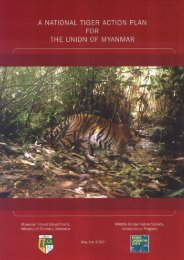Thailand Tiger Action Plan - Global Tiger Initiative
Thailand Tiger Action Plan - Global Tiger Initiative
Thailand Tiger Action Plan - Global Tiger Initiative
You also want an ePaper? Increase the reach of your titles
YUMPU automatically turns print PDFs into web optimized ePapers that Google loves.
self esteem among park rangers. <strong>Tiger</strong>s and prey havesubsequently been better protected and are recovering.• Intensive long-term monitoring of tigers using camera trappingand capture-based models: <strong>Tiger</strong> population monitoring is anintegral part of the management scheme for tiger conservation.Since 2005 the annual systematic camera trapping programcovering about 1,000 km 2 sample area has revealed a density ofabout 2-3 tigers per 100 km 2 and has shown it is stable. Between7-12 new tigers were captured annually. Camera trapping in ThungYai Wildlife Sanctuaries has alternated yearly between Thung YaiEast and Thung Yai West Wildlife Sanctuaries.Management and Monitoring at the Landscape Level:• Wildlife crime units and wild meat restaurant database: Theseare a major intervention to control the demands of wild meat fromoutside Huai Kha Khaeng Wildlife Sanctuary and other protectedareas next to HKK. A wildlife crime unit was established at theProtected Area Administrative Office (PAAO) 12 (NakornsawanProvince) to gather information and enforce wildlife law outsideWEFCOM. The unit also gathers information from the wildlife crimeweb-based database, created for the public to inform them aboutplaces around WEFCOM where there is suspected trading of illegalwildlife and wild meat. The tracking of illegal wild meat traffickinghas become more systematic and enforcement has become morefocused.• Public campaign with the focus on communities around HuaiKha Khaeng Wildlife Sanctuary: A focused campaign using thetiger as an iconic species has been launched with strong supportfrom local sub-district administration offices and schools. It focuseson wild meat restaurants, local schools, and communities adjacentto Huai Kha Khaeng Wildlife Sanctuary. The campaign uses themanual “Teachers for <strong>Tiger</strong>s” to work with local schools. Thisfocused campaign has gained clearer and stronger support fromlocal communities on the work to save tigers in HKK and WEFCOM.• Occupancy survey: To survey tigers within WEFCOM a landscapeoccupancy monitoring system has been adopted. DNP researchershave worked with support from NGO partners to conduct thesystematic survey of WEFCOM in 2010-2011 and plan to do this inevery 3-4 years. The teams walk along the designated grid cellslooking for tiger tracks and signs. The monitoring system allows foran understanding of the patterns of tiger distribution in WEFCOMlandscape and the change in patterns following the managementquality.The Department of National Parks, Wildlife and <strong>Plan</strong>t Conservation hasstarted to scale up the model to eight other wildlife sanctuaries and fivenational parks.
















